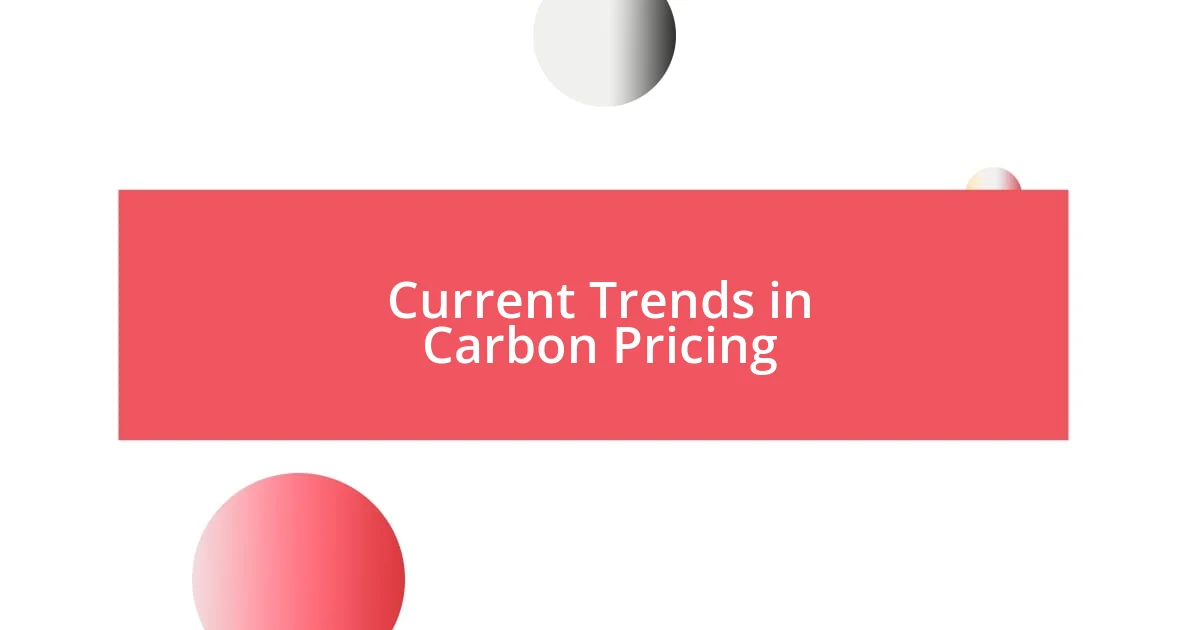Key takeaways:
- Carbon markets create economic incentives for reducing emissions, demonstrating their potential to reshape corporate environmental responsibility.
- Current trends in carbon pricing include broader coverage of sectors, rising prices, market linking, increased transparency, and a focus on social co-benefits.
- Technological innovations, especially blockchain and AI, are enhancing transparency, optimizing trading strategies, and facilitating a more accessible carbon trading environment.

Understanding Carbon Markets
Carbon markets represent a powerful mechanism for addressing climate change by allowing businesses and countries to buy and sell emissions allowances. I remember feeling a spark of hope when I first learned how these markets functioned—they create an economic incentive for reducing carbon emissions. It’s fascinating to consider how a financial exchange can lead to tangible environmental benefits.
As I delved deeper, I was struck by the complexity of these markets. Different systems exist globally, from cap-and-trade to offset programs, each with its strengths and weaknesses. Have you ever wondered how much influence these markets have over government policies and corporate behavior? My experience in observing various industries adapting to these frameworks showed me that carbon markets can really reshape how companies approach environmental responsibility.
I once participated in a workshop where experts discussed the future of carbon markets, and the energy in the room was palpable. The potential for innovation is immense, as new technologies and strategies emerge to track and trade carbon credits effectively. I can’t help but think about the responsibility we all share in understanding and participating in these markets—it’s not just about numbers; it’s about creating a sustainable future for the next generations.

Current Trends in Carbon Pricing
Current trends in carbon pricing are evolving rapidly, reflecting both market dynamics and regulatory shifts. I recently attended a panel discussion where experts highlighted an increasing number of countries adopting carbon pricing mechanisms. It reminded me of my own journey in understanding these systems—each step revealed how interconnected our global responses to climate change truly are.
Here are some key trends shaping carbon pricing today:
-
Broadened Scope: Many jurisdictions are expanding their carbon pricing to include more sectors, such as transportation and agriculture. This shift speaks volumes about the push towards comprehensive climate strategies.
-
Rising Prices: As demand for allowances increases, many carbon markets are witnessing a substantial rise in prices. This surge may incentivize companies to invest in greener technologies—something that excites me greatly.
-
Linking Markets: I’ve observed an interesting trend where different carbon markets are beginning to link up. This integration allows for a more fluid trading environment and can enhance overall efficiency.
-
Increased Transparency: The growing call for transparency in how carbon credits are generated and traded is essential. I remember a time when the complexity of offset programs left me confused; clearer guidelines can empower more stakeholders to participate effectively.
-
Focus on Co-benefits: We’re now seeing emphasis not just on carbon reduction but also on social and environmental co-benefits. Programs that address local air quality while reducing emissions resonate with communities, and I personally appreciate this holistic view.
These developments showcase a more robust and interconnected approach to tackling climate change, which, I believe, holds much promise for a sustainable future.

Technology Innovations in Carbon Trading
Technology is revolutionizing carbon trading in ways that I didn’t anticipate. For example, the advent of blockchain technology has transformed how transactions are recorded and verified. I remember learning about a platform that uses blockchain to ensure transparency and traceability in carbon credit transactions, which got me thinking about how trust can lead to wider participation in these markets.
As companies adopt artificial intelligence and data analytics, it’s fascinating to see how they predict market trends and optimize trading strategies. I was recently inspired by a case study where a company utilized predictive algorithms to forecast demand for carbon credits, allowing them to adjust their purchasing strategies effectively. This not only maximizes profits but also promotes proactive measures in reducing emissions.
| Technology | Impact on Carbon Trading |
|---|---|
| Blockchain | Enhances transparency and trust in transactions. |
| Artificial Intelligence | Optimizes trading strategies and forecasts market trends. |
| Data Analytics | Aids in assessing impact and tracking overall emissions. |

Future Predictions for Carbon Trading
Looking ahead, I see a world where carbon markets could become more standardized and interconnected globally. I often find myself pondering how different systems can learn from one another. For instance, imagine a future where a company in Europe can seamlessly trade carbon credits with one in Asia, all thanks to harmonized regulations. The thought both excites and intrigues me, as it opens the door for collaboration on a scale we’ve never seen before.
Moreover, I believe that as awareness of climate change intensifies, consumer pressure will drive more businesses toward carbon neutrality. Just the other day, I had an enlightening conversation with a local business owner who recognized that customers are increasingly favoring eco-friendly products. It’s this kind of attitude shift that will likely push companies to engage more earnestly in carbon trading, leading to a more vibrant marketplace.
Lastly, the expected rise in voluntary carbon markets is something I’m particularly passionate about. I recall a workshop where we discussed how individuals and businesses can directly support environmental projects through offset purchases. This not only empowers them but could also transform the fabric of carbon trading, making it more accessible and personal for everyday people. Isn’t it inspiring to think about a community where everyone feels like a stakeholder in the climate journey?















